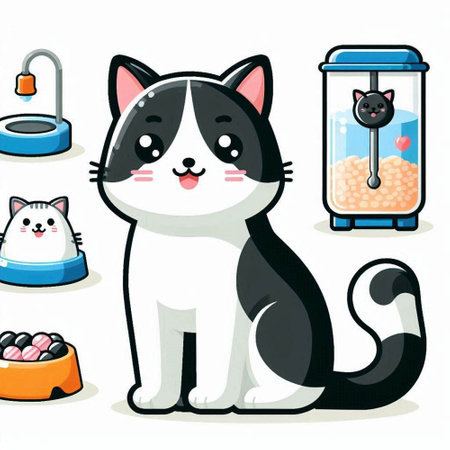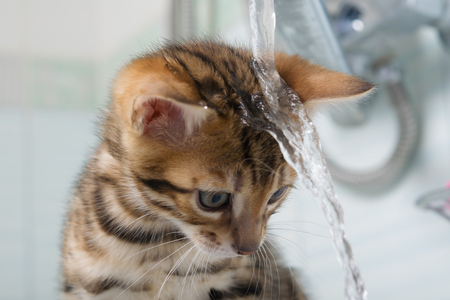Understanding Why Hydration Matters for Cats
Proper hydration is the cornerstone of your cat’s health, playing a critical role in everything from kidney function to digestion and general vitality. Many American households are home to cats who, unlike their canine companions, tend to have low thirst drives—a trait inherited from their desert-dwelling ancestors. This makes it especially important for cat owners in the U.S. to be proactive about ensuring their feline friends get enough water. Well-hydrated cats are less likely to develop urinary tract issues or kidney disease, two health problems that are unfortunately common in American indoor cats. Furthermore, adequate water intake helps regulate body temperature and supports nutrient absorption, keeping your kitty lively and comfortable whether they’re basking in a sunny window or chasing after a feather toy. By understanding just how vital hydration is, you’re taking the first step toward helping your cat thrive in every stage of life.
Common Reasons Cats Don’t Drink Enough Water
If you’ve ever noticed your cat’s water bowl sitting untouched for hours, you’re not alone. There are several common reasons why our feline friends often don’t drink as much water as they should, and understanding these factors is the first step in helping them stay hydrated and healthy.
Dry Food Diets
One of the main culprits behind low water intake is a dry food diet. Kibble contains only about 10% moisture, while a cat’s natural prey would provide around 70-80% water content. This significant difference means that cats eating mainly dry food need to compensate by drinking more water—but many simply don’t.
Diet Type and Moisture Content Comparison
| Diet Type | Average Moisture Content |
|---|---|
| Dry Kibble | ~10% |
| Canned/Wet Food | ~75-80% |
| Raw/Prey | ~70-75% |
Picky Preferences
Cats are notorious for being particular about their water sources. They might dislike the taste or temperature of tap water, be turned off by a plastic bowl, or prefer running water over still. Some kitties even refuse to drink if their bowl is placed too close to their food or litter box—talk about high standards!
Environmental Stressors
Changes in the home environment, like new pets, loud noises, or moving furniture, can stress out your cat and lead to decreased water consumption. Even seasonal changes, such as turning on the heater during winter, can impact how much your furry friend drinks each day.
Quick Glance: Why Cats Skip Sips
- Kibble-heavy diets with low moisture
- Sensitivity to water taste or bowl material
- Preference for running vs. still water
- Bowl placement (too close to food or litter)
- Stress from environmental changes
Recognizing these common obstacles helps us create a more inviting hydration routine for our cats—making sure they get all the water they need to thrive in our cozy homes and gardens.

3. Signs Your Cat May Be Dehydrated
If you’re a cat parent living the cozy, pet-filled American dream, it’s important to keep a watchful eye on your feline friend—especially when it comes to hydration. Cats are notorious for hiding discomfort, so spotting dehydration early is key to their health and happiness. Here are some telltale signs that your kitty may need more water:
Physical Indicators
One of the quickest ways to check for dehydration in cats is the skin tent test. Gently pinch the skin between your cat’s shoulder blades—if it doesn’t snap back quickly, your cat may be dehydrated. You might also notice dry or sticky gums, sunken eyes, and a dry nose. These physical signs are often the first clues that your whiskered companion isn’t getting enough fluids.
Behavioral Changes
Dehydrated cats can become lethargic or less playful than usual—a big red flag if your normally curious companion starts lounging around more than chasing sunbeams or bird-watching from the window. You might also notice a loss of appetite, increased panting (even without heat), or reluctance to groom themselves. Any sudden change in your cat’s daily routine is worth paying attention to.
Health Concerns
Keep an eye out for constipation, unusually dark or strong-smelling urine, and vomiting. These can all be subtle signs that something’s off with your cat’s hydration. In more serious cases, dehydration can lead to kidney problems or urinary tract issues—health concerns that are especially common among indoor cats in U.S. households.
When to Seek Veterinary Help
If you spot any combination of these symptoms, it’s time to consult your veterinarian. Prompt attention can prevent more serious health complications down the road—and help ensure your furry family member stays healthy and hydrated for all those sun-dappled afternoon naps together.
4. Creative Ways to Encourage Your Cat to Drink More
Keeping your feline friend hydrated can be a challenge, especially if you have a picky cat who turns up their nose at a regular water bowl. Luckily, there are several clever strategies that work well in American homes to make water more appealing and accessible. Here are some practical tips to boost your cat’s hydration and keep them healthy year-round.
Pet Water Fountains: A Game Changer
Cats are naturally attracted to running water, which is why pet water fountains are increasingly popular among American pet parents. These fountains provide a continuous stream of filtered water, keeping it fresh and oxygenated. Not only does this encourage cats to drink more, but the gentle sound of flowing water can also be soothing for both pets and their owners. Place the fountain in a quiet, low-traffic area where your cat feels safe exploring.
Wet Food: Adding Moisture to Their Diet
If your cat prefers kibble, consider mixing in wet food or even switching entirely to canned varieties. Wet cat food contains much higher moisture content than dry food, helping cats get essential fluids with every meal. You can also add a splash of warm water or low-sodium chicken broth (without onions or garlic) to their meals for an extra hydration boost.
Multiple Water Stations Around the House
Just like us, cats appreciate convenience! Placing several water bowls in different locations—especially in multi-story homes—can remind your kitty to take a drink during their daily adventures. Try to use ceramic, glass, or stainless steel bowls rather than plastic ones, as they’re less likely to retain odors and bacteria.
Quick Reference Table: Hydration Boosters for Cats
| Tip | How It Helps | Best for… |
|---|---|---|
| Pet Fountain | Keeps water fresh and moving; attracts cats who love running water | Picky or playful cats; homes with multiple pets |
| Wet Food | Adds moisture directly into diet; easy transition from dry food | Cats with low thirst drive; older cats |
| Multiple Bowls | Makes water readily available throughout the home | Large houses; multi-cat households |
| Add Broth to Food | Enhances flavor and increases liquid intake at mealtime | Picky eaters; cats recovering from illness |
| Change Water Daily | Keeps taste fresh and appealing; removes debris or fur | All cats—especially sensitive ones! |
Extra Tips for American Households:
- If you have kids or other pets, place at least one bowl in a spot that’s quiet and away from busy areas—your cat will appreciate the privacy.
- Consider seasonal changes—during hot summers, check bowls frequently and add ice cubes for cool refreshment.
- If you have dogs, try using elevated stands so your cat has their own space away from canine siblings.
By getting creative and thinking about your home’s unique layout and your cat’s preferences, you’ll make drinking water a fun and natural part of their day. Your furry companion will thank you with more energy—and maybe even a few extra purrs!
5. Hydration and Multi-Pet Living
Living in a lively household with multiple pets can be a joyful experience, but it also comes with unique challenges—especially when it comes to making sure every cat stays properly hydrated. Cats are sensitive creatures, and sharing resources like water bowls can sometimes lead to stress or competition, especially if you have both cats and dogs, or several felines with different personalities. To help ensure that each of your furry friends gets enough fresh water without feeling anxious, it’s wise to provide multiple water stations throughout your home. Place bowls in quiet, low-traffic areas where your cats feel safe to drink undisturbed. If you notice any of your cats are shy or tend to get bullied away from communal bowls, consider setting up a special spot just for them.
Keep Water Fresh and Appealing
Regularly changing the water and cleaning the bowls is crucial—not only does this keep things hygienic, but it also makes the water more enticing for picky drinkers. Consider using ceramic or stainless steel bowls, as these materials don’t retain odors the way plastic can. Some multi-pet families find great success with pet water fountains, which provide a continuous flow and help mimic the fresh streams cats instinctively prefer in nature.
Monitor Individual Drinking Habits
It’s easy to lose track of how much each cat is drinking when you have a bustling pet household. Try to observe each cat individually at least once a day to ensure they’re visiting the water stations regularly. If possible, place a bowl on each level of your home so no one has to travel far—older cats especially appreciate not having to climb stairs for a sip.
Reduce Competition and Stress
In homes with both cats and dogs, make sure feline-friendly water sources are placed where only the cats can access them. Elevated surfaces or tucked-away corners work well for this purpose. By giving each cat their own safe space for hydration, you help prevent stress-related issues like urinary problems and encourage healthy habits for every member of your four-legged family.
6. When to Seek Help: Hydration and Vet Visits
Even with the best efforts, sometimes our feline companions still don’t drink enough water, and dehydration can sneak up on them. It’s important to know when it’s time to consult your veterinarian. If you notice signs like lethargy, sunken eyes, dry gums, loss of skin elasticity (try gently pinching the skin at the back of your cat’s neck—if it doesn’t spring back quickly, that’s a red flag), or if your kitty refuses food and water for more than 24 hours, it’s time to seek professional help. Don’t wait, especially if your cat is elderly or has underlying health conditions.
What to Expect During a Vet Visit in the U.S.
Your vet will likely ask about your cat’s drinking habits, diet, recent behavior changes, and may perform a physical exam. They might run tests like blood work or urinalysis to check hydration levels and kidney function. Don’t be surprised if the clinic staff recommends subcutaneous fluids—these are often administered under the skin to quickly rehydrate your pet. American veterinary clinics are well-equipped and focused on making both pets and their humans comfortable, so feel free to ask questions and share any observations you’ve made at home.
Don’t Delay Professional Care
In rural areas or small towns, you might have a trusted local vet who knows your pets well; in larger cities, you’ll find clinics with extended hours and emergency services. Wherever you live in the U.S., timely action is crucial. Hydration issues can signal underlying problems such as kidney disease or diabetes, which need prompt attention. It’s always better to err on the side of caution—your quick response could make all the difference in keeping your cat healthy and happy.


